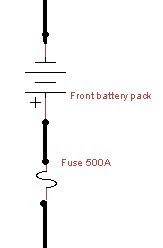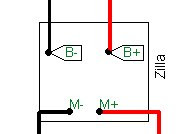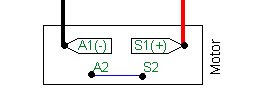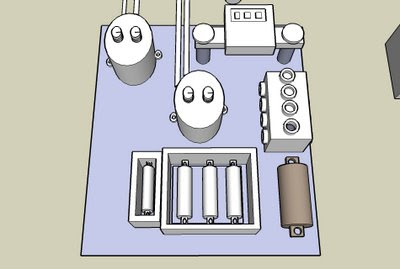Over the weekend I finished as much of the wiring of the high voltage box as I could. Until I mount the controller and build the front battery racks I can't finish the wiring. And I can't do either of those until the adapter arrives and the transmission and motor are installed. I may start on the rear battery racks over the weekend since this is independent of what is going on in the front of the car.
Since I'm just waiting I figured this is a good time to review some EV stuff. So today I'll write "Lesson 1: EV wiring for dummies" (dummies describing the author's level of expertise on this subject, not the readers :-)
Circuitry in the vehicle can basically be divided into two groups: low voltage(12V) and high voltage(144V) . Low voltage circuits are the type of circuits already in the vehicle . They power the lights, instruments, wipers, etc. High voltage circuits are being added and power the electric motor and a few new accessories.
This is a diagram of the main traction circuit.

Let's take a closer look at this circuit. The car I am building is powered by twenty-four 6-volt batteries for a total of 144 volts. The batteries are divided into two packs. Below is the rear battery pack. As the name "pack" implies it consists of more than one battery. The rear pack contains 15 batteries.

All the batteries hooked together can be thought of as one big battery. An analogy would be a flashlight. A small flashlight consists of a single battery with a positive and a negative end. Connect a light bulb between the two and it lights up. If you need more power you get a bigger flashlight which may have two batteries "end to end" (in series). Or you can go even bigger and get one with more batteries. In either case you have multiple smaller batteries that act as one bigger battery.
The Anderson connector is just a special plug that allows the motor to "plug into" the batteries. It is the same as when you plug a lamp into an outlet. It's easier to do that then have to wire the lamp into the fuse box every time you want to connect it.
From the rear battery pack the circuit goes in two directions. There is a negative leg and a positive leg. Eventually the two legs meet up at the motor to complete the circuit and provide power. Let's follow the negative leg first.
The next components in this leg are a fuse and the front battery pack.

The purpose of the fuse is to protect the wiring and components in case of a short circuit. As eluded to in an earlier post it is analogous to the circuit breakers in your house. If an appliance or lamp in your house short circuits the breaker cuts power to that circuit to prevent further damage.
The fuse is connected to the front battery pack. This is the same as the rear battery pack except only contains nine batteries. Because of weight distribution and size constraints all of the batteries cannot be put together in one location.
Next is the shunt.

It is connected to the rear battery back by a plug. The purpose of the shunt is to allow instrumentation to measure the voltage of the pack and the current going through the traction circuit.
Next in line is the contactor.

The contactor is essentially and on/off switch. When the switch is open no current flows through the circuit. When closed the circuit is completed. (Actually in my conversion there are two switches that need to be closed to complete the circuit and this is one of those two.)
After the contact comes the "Zilla".

"Zilla" is the brand name of the controller that I am using. The controller is the brains of the EV conversion. At its most basic level a controller regulates the flow of electricity to the motor.
Finally comes the motor. All that electricity has to go somewhere :-)

From the rear battery pack the positive leg of the circuit is essentially the same as the negative leg. The main differences: no more batteries added and no fuse (since the fuse on the negative leg protects the entire circuit).
That's the end of lesson one. I would give out a homework assignment except I'm too lazy to have to grade all of them :-) And remember, all information discussed will be on the final exam!




















